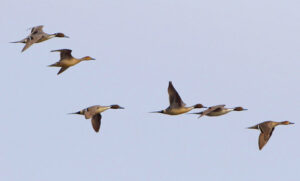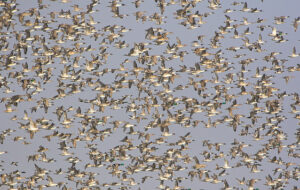Northern Pintail, Anas acuta
Bill Rowe
Of all the many ducks that migrate through the Midwest, spring and fall, the Northern Pintail is one of the classiest, with its handsome color scheme (male only) and its elegant, long-necked silhouette in flight. It also has an enormous breeding range across the north-central states, Canada, Alaska, northeastern Europe, and all of Russia, and it is known as a winter resident as far down into the tropics as Colombia, central Africa, and southeast Asia. It rivals the Mallard in the breadth of its distribution though not in its population, which in Canada and the U.S. is around 3 million (versus perhaps 10 million for the Mallard) Good nesting habitat for pintails varies from the Arctic tundra to the “prairie potholes” of the northern Great Plains, i.e., the countless lakes, ponds, and marshy sloughs that are tucked into the vast grasslands of that region. This habitat is home not only to the pintail but to scores of other ducks, grebes, shorebirds, and songbirds; it’s a “bird factory” that is subject to perils like drought and the conversion of grassland into cropland. On the other hand, it is also subject to vigorous conservation efforts by such groups as the U.S. Fish and Wildlife Service, the Nature Conservancy, and Ducks Unlimited. Efforts like these, through wetland preservation, protect not only the waterfowl that hunters value but also the birds and other wildlife of all types that make their home in the same duck-breeding sloughs. A side note: this is one of many birds named with a special adjective like “Northern,” which serves to distinguish them from similar species elsewhere but not here in the U.S. So, in conversation, it makes sense to call these ducks simply “pintails” and reserve the full formal name for lists and other publications.
IDENTIFICATION: As with most other ducks, male pintails wear a female-like “eclipse” plumage in summer (see Blue-winged Teal article), then molt back into their familiar “regular” plumage during the fall. Once they regain this plumage, they are unmistakable on water or land, with gray sides, white breasts, and chocolate-brown heads that have a thin white streak curling up the back. Females, juveniles, and eclipse males are mottled brown, distinguished from Mallards and others by their plain, unmarked warm-brown heads, gray bills, and long-necked, pointy-tailed profiles. In the air, this profile marks both sexes of the pintail immediately (see below left).
ST. LOUIS STATUS: A common fall migrant, beginning with small numbers in August and peaking in early November. Less numerous in winter but still present, depending on water conditions. Common once again in early spring, February to April.
Learn more and listen to the calls of Northern Pintails here.


Small group in flight
Photo Credit: Al Smith
Big flock in flight
Photo Credit: Al Smith




